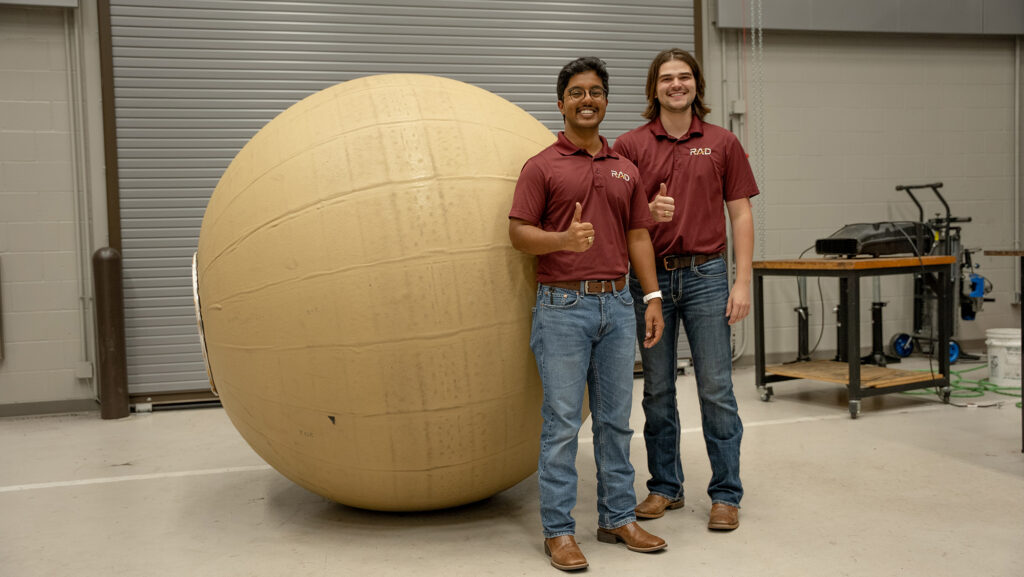High-precision process monitoring and error detection in additive manufacturing
How a Gemma model helped discover a new potential cancer therapy pathway
3D-printed microrobots adapt to diverse environments with modular design
‘Metabots’ shapeshift from flat sheets into hundreds of structures
Soft skin allows vine robots to navigate complex, fragile environments
Introducing Veo 3.1 and advanced creative capabilities
Programming robots with rubber bands
Smart Supply Chain Strategies for Cold Storage: Solving Challenges with Scalable Automation
What’s coming up at #IROS2025?

The 2025 IEEE/RSJ International Conference on Intelligent Robots and Systems (IROS 2025) will be held from 19-25 October in Hangzhou, China. The programme includes plenary and keynote talks, workshops, tutorials, forums, competitions, and a debate.
Plenary talks
There are three plenary talks on the programme this year, with one per day on Tuesday 21, Wednesday 22, and Thursday 23 October.
- Marco Hutter – The New Era of Mobility: Humanoids and Quadrupeds Enter the Real World
- Hyoun Jin Kim – Autonomous Aerial Manipulation: Toward Physically Intelligent Robots in Flight
- Song-Chun Zhu – TongBrain: Bridging Physical Robots and AGI Agents
Keynote talks
The keynotes this year fall under eleven umbrella topics:
- Rehabilitation & Physically Assistive Systems
- Patrick Wensing – From Controlled Tests to Open Worlds: Advancing Legged Robots and Lower-Limb Prostheses
- Hao Su – AI-Powered Wearable and Surgical Robots for Human Augmentation
- Lorenzo Masia – Wearable Robots and AI for Rehabilitation and Human Augmentation
- Shingo Shimoda – Science of Awareness: Toward a New Paradigm for Brain-Generated Disorders
- Bio-inspired Robotics
- Kevin Chen – Agile and robust micro-aerial-robots driven by soft artificial muscles
- Josie Hughes – Bioinspired Robots: Building Embodied Intelligence
- Jee-Hwan Ryu – Soft Growing Robots: From Disaster Response to Colonoscopy
- Lei Ren – Layagrity robotics: inspiration from the human musculoskeletal system
- Soft Robotics
- Bram Vanderborght – Self healing materials for sustainable soft robots”
- Cecilia Laschi – From AI Scaling to Embodied Control: Toward Energy-Frugal Soft Robotics
- Kyu-Jin Cho – Soft Wearable Robots: Navigating the Challenges of Building Technology for the Human Body
- Li Wen – Multimodal Soft Robots: Elevating Interaction in Complex and Diverse Environments
- Al and Robot Learning
- Fei Miao – From Uncertainty to Action: Robust and Safe Multi-Agent Reinforcement Learning for Embodied AI
- Xifeng Yan – Adaptive Inference in Transformers
- Long Cheng – Learning from Demonstrations by the Dynamical System Approach
- Karinne Ramírez-Amaro – Transparent Robot Decision-Making with Interpretable & Explainable Methods
- Perception and Sensors
- Davide Scaramuzza – Low-latency Robotics with Event Cameras
- Kris Dorsey – Sensor design for soft robotic proprioception
- Perla Maiolino – Shaping Intelligence: Soft Bodies, Sensors, and Experience
- Roberto Calandra – Digitizing Touch and its Importance in Robotics
- Human Robot Interaction
- Javier Alonso-Mora – Multi-Agent Autonomy: from Interaction-Aware Navigation to Coordinated Mobile Manipulation
- Jing Xiao – Robotic Manipulation in Unknown and Uncertain Environments
- Dongheui Lee – From Passive Learner to Pro-Active and Inter-Active Learner with Reasoning Capabilities
- Ya-Jun Pan – Intelligent Adaptive Robot Interacting with Unknown Environment and Human
- Embodied Intelligence
- Fumiya Iida – Informatizing Soft Robots for Super Embodied Intelligence
- Nidhi Seethapathi – Predictive Principles of Locomotion
- Cewu Lu – Digital Gene: An Analytical Universal Embodied Manipulation Ideology
- Long Cheng – Learning from Demonstrations by the Dynamical System Approach
- Medical Robots
- Kenji Suzuki – Small-data Deep Learning for AI Doctor and Smart Medical Imaging
- Li Zhang – Magnetic Microrobots for Translational Biomedicine: From Individual and Modular Designs to Microswarms
- Kanako Harada – Co-evolution of Human and AI-Robots to Expand Science Frontiers
- Loredana Zollo – Towards Synergistic Human–Machine Interaction in Assistive and Rehabilitation Robotics: Multimodal Interfaces, Sensory Feedback, and Future Perspectives
- Field Robotics
- Matteo Matteucci – Robotics Meets Agriculture: SLAM and Perception for Crop Monitoring and Precision Farming
- Brendan Englot – Situational Awareness and Decision-Making Under Uncertainty for Marine Robots
- Abhinav Valada – Open World Embodied Intelligence: Learning from Perception to Action in the Wild
- Timothy H. Chung – Catalyzing the Future of Human, Robot, and AI Agent Teams in the Physical World
- Humanoid Robot Systems
- Kei Okada – Transforming Humanoid Robot Intelligence: From Reconfigurable Hardware to Human-Centric Applications
- Xingxing Wang – A New Era of Global Collaboration in Intelligent Robotics
- Wei Zhang – Towards Physical Intelligence in Humanoid Robotics
- Dennis Hong – Staging the Machine: Not Built for Work, Built for Wonder
- Mechanisms and Controls
- Kenjiro Tadakuma – Topological Robotic Mechanisms
- Angela P. Schoellig – AI-Powered Robotics: From Semantic Understanding to Safe Autonomy
- Lu Liu – Safety-Aware Multi-Agent Self-Deployment: Integrating Cybersecurity and Constrained Coordination
- Fuchun Sun – Knowledge-Guided Tactile VLA: Bridging the Sim-to-Real Gap with Physics and Geometry Awareness
Debate
On Wednesday, a debate will be held on the following topic: “Humanoids Will Soon Replace Most Human Workers: True or False?” The participants will be: XingXing Wang (Unitree Robotics), Jun-Oh Ho (Samsung and Rainbow Robotics), Hong Qiao (Chinese Academy of Sciences), Andra Keay, (Silicon Valley Robotics), Yu Sun (EiC, IEEE Trans on Automation Science and Engineering), Tamim Asfour (Professor of Humanoid Robotics, Karlsruhe Institute of Technology), Ken Goldberg (UC Berkeley, Moderator).
Tutorials
There are three tutorials planned, taking place on Monday 20 and Friday 24 October.
- Enhancing Digital Accessibility in Higher Education
- Design and Development of Rehabilitation Robotic Devices: Healthcare Challenges
- Retico: A Framework for Robot-ready Spoken Dialogue with Robots
Workshops
You can find a list of the workshops here. These will take place on Monday 20 and Friday 24 October.There are 83 to choose from this year.
Find out more
Robot ‘backpack’ drone launches, drives and flies to tackle emergencies
The SPT-1500UL from SEER Robotics
Scientists build artificial neurons that work like real ones
How AI and Integration Are Transforming Software Security
I wrote last month that AI has made it easier than ever to produce code—and just as easy to produce insecure code. Development velocity has exploded. So have vulnerabilities. We’re now writing, generating, and deploying software faster than most organizations […]
The post How AI and Integration Are Transforming Software Security appeared first on TechSpective.
From sea to space, this robot is on a roll
 Rishi Jangale and Derek Pravecek with RoboBall III. Image credit: Emily Oswald/Texas A&M Engineering.
Rishi Jangale and Derek Pravecek with RoboBall III. Image credit: Emily Oswald/Texas A&M Engineering.
By Alyssa Schaechinger
While working at NASA in 2003, Dr. Robert Ambrose, director of the Robotics and Automation Design Lab (RAD Lab), designed a robot with no fixed top or bottom. A perfect sphere, the RoboBall could not flip over, and its shape promised access to places wheeled or legged machines could not reach — from the deepest lunar crater to the uneven sands of a beach. Two of his students built the first prototype, but then Ambrose shelved the idea to focus on drivable rovers for astronauts.
When Ambrose arrived at Texas A&M University in 2021, he saw a chance to reignite his idea. With funding from the Chancellor’s Research Initiative and Governor’s University Research Initiative, Ambrose brought RoboBall back to life.
Now, two decades after the original idea, RoboBall is rolling across Texas A&M University.
Driven by graduate students Rishi Jangale and Derek Pravecek, the RAD Lab is intent on sending RoboBall, a novel spherical robot, into uncharted terrain.
Jangale and Pravecek, both Ph.D. students in the J. Mike Walker ’66 Department of Mechanical Engineering, have played a significant part in getting the ball rolling once again.
“Dr. Ambrose has given us such a cool opportunity. He gives us the chance to work on RoboBall however we want,” said Jangale, who began work on RoboBall in 2022. “We manage ourselves, and we get to take RoboBall in any direction we want.”
Pravecek echoed that sense of freedom. “We get to work as actual engineers doing engineering tasks. This research teaches us things beyond what we read in textbooks,” he said. “It really is the best of both worlds.”
Robot in an airbag
At the heart of the project is the simple concept of a “robot in an airbag.” Two versions now exist in tandem. RoboBall II, a 2-foot-diameter prototype, is tuned for trial runs, monitoring power output and control algorithms. RoboBall III has a diameter of 6 feet across and is built with plans to carry payloads such as sensors, cameras or sampling tools, for real-world missions.
Upcoming tests will continue to take RoboBall into outdoor environments. RAD Lab researchers are planning field trials on the beaches of Galveston to demonstrate a water-to-land transition, testing the robot’s buoyancy and terrain adaptability in a real-world setting.
“Traditional vehicles stall or tip over in abrupt transitions,” Jangale explained. “This robot can roll out of water onto sand without worrying about orientation. It’s going where other robots can’t.”
The factors that create the versatility of RoboBall also lead to some of its challenges. Once sealed inside its protective shell, the robot can only be accessed electronically. Any mechanical failure means disassembly and digging through layers of wiring and actuators.
“Diagnostics can be a headache,” said Pravacek. “If a motor fails or a sensor disconnects, you can’t just pop open a panel. You have to take apart the whole robot and rebuild. It’s like open-heart surgery on a rolling ball.”
RoboBall’s novelty means the team often operates without a blueprint.
“Every task is new,” Jangale said. “We’re very much on our own. There’s no literature on soft-shelled spherical robots of this size that roll themselves.”
Despite those hurdles, the students find themselves surprised every time the robot outperforms expectations.
“When it does something we didn’t think was possible, I’m always surprised,” Pravecek said. “It still feels like magic.”
Student-led innovation
The team set a new record when RoboBall II reached 20 miles per hour, roughly half its theoretical power output. “We didn’t anticipate hitting that speed so soon,” Pravecek said. “It was thrilling, and it opened up new targets. Now we’re pushing even further.”
Ambrose sees these reactions as proof that student-led innovation thrives when engineers have room to explore.
“The autonomy Rishi and Derek have is exactly what a project like this needs,” he said. “They’re not just following instructions — they’re inventing the next generation of exploration tools.”
Long-term goals include autonomous navigation and remote deployment. The team hopes to see RoboBall dispatched from a lunar lander to chart steep crater walls or launched from an unmanned drone to survey post-disaster landscapes on Earth. Each ball could map terrain, transmit data back to operators and even deploy instruments in hard-to-reach spots.
“Imagine a swarm of these balls deployed after a hurricane,” Jangale said. “They could map flooded areas, find survivors and bring back essential data — all without risking human lives.”
As the RoboBall project rolls on, student-driven research stands on full display.
“Engineering is problem solving at its purest,” Ambrose said. “Give creative minds a challenge and the freedom to explore, and you’ll see innovation roll into reality.”